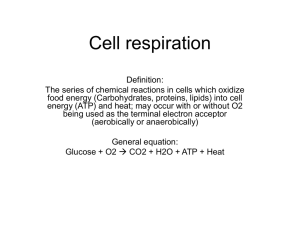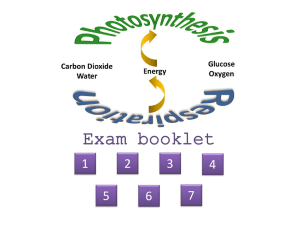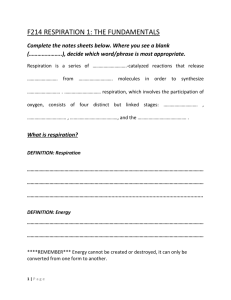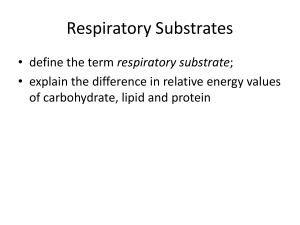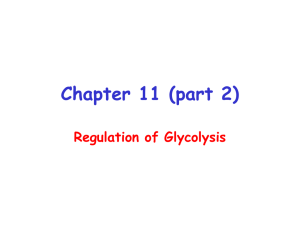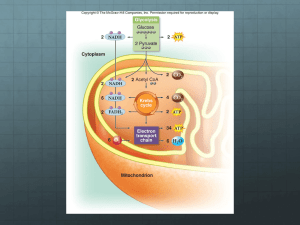Respiration - WordPress.com
advertisement
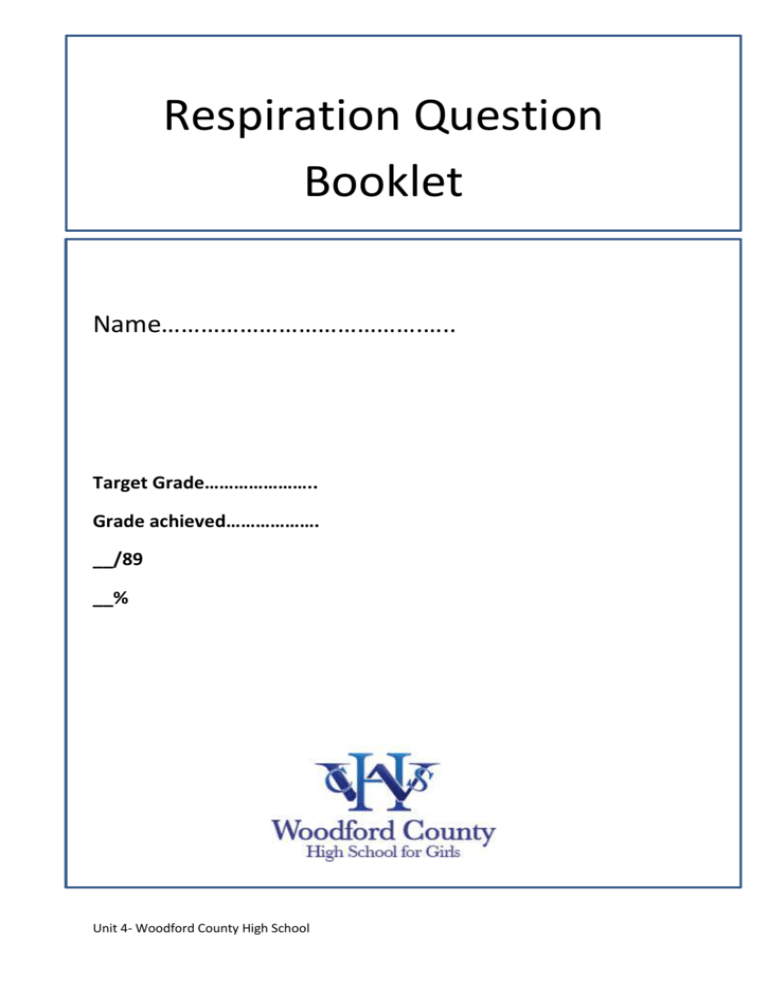
Respiration Question Booklet Name………………………………….….. Target Grade………………….. Grade achieved………………. __/89 __% Unit 4- Woodford County High School 1. The diagram shows the biochemical pathway involved when one molecule of glucose is respired aerobically. Glucose 2 ATP 4 ATP 2 reduced NAD Pyruvate 2 Z 2 reduced NAD Acetylcoenzyme A Krebs Cycle 2 reduced FAD 4 Z 2 ATP 6 reduced NAD Each reduced NAD molecule leads to the production of 3 ATP molecules. Each reduced FAD molecule leads to the production of 2 ATP molecules. (a) Identify the compound represented by the letter Z. .................................................................................................................................... (1) (b) Using the information in the diagram, calculate the net number of ATP molecules produced from one molecule of glucose during aerobic respiration. Net number of ATP molecules............................ (1) Unit 4- Woodford County High School (c) (i) Describe the part played by oxygen in the process of aerobic respiration. .......................................................................................................................... . .......................................................................................................................... . .......................................................................................................................... . (2) (ii) In the absence of oxygen, anaerobic respiration occurs. In animals, this involves the conversion of pyruvate into lactate without the production of any more ATP molecules. How many molecules of ATP are produced from each glucose molecule in anaerobic respiration ? .......................................................................................................................... .......................................................................................................................... (1) (Total 5 marks) 2. (a) The diagram shows part of a cell. Use a label line and the letter ‘K’ to indicate where Krebs cycle occurs, and another line with the letter ‘G’ to indicate the site of glycolysis. Cell surface membrane (2) Unit 4- Woodford County High School (b) (i) Name two substances for which there would be net movement into the mitochondria. 1........................................................................................................................ . 2........................................................................................................................ . (2) (ii) Name one substance for which there would be net movement out of the mitochondria. .......................................................................................................................... . (1) (c) (i) Glucose is oxidised to pyruvate during the process of glycolysis. Explain why glycolysis is said to involve oxidation. .......................................................................................................................... . .......................................................................................................................... . (1) (ii) Explain why ATP is necessary for glycolysis. .......................................................................................................................... . .......................................................................................................................... . (1) (Total 7 marks) Unit 4- Woodford County High School 3. The diagram shows two stages occurring in aerobic respiration. glucose stage I pyruvate stage II carbon dioxide + water Each of the events or descriptions in the table applies to one or both of the stages. Tick the appropriate boxes to show the stage or stages in which each is involved. Event or description Stage I Stage II Glycolysis Takes place inside the mitochondrion Acetylcoenzyme A is involved ATP is synthesised from ADP Reduced NAD is re-oxidised (Total 5 marks) Unit 4- Woodford County High School 4. In an experiment, lactate containing radioactive carbon was added to a preparation of muscle tissue in the presence of oxygen. The muscle preparation was able to respire some of the lactate and this provided the energy needed to convert the remaining lactate into glycogen. The diagram summarises the biochemical steps involved. Glycogen A Glucose B C D Lactate (a) Pyruvate Carbon dioxide + water Which one of the labelled arrows shows a biochemical conversion in muscle that can proceed only in the direction shown? ................................................... (1) (b) Give the names of the stages in aerobic respiration in which energy is made available from the respiration of lactate. .................................................................................................................................... .................................................................................................................................... (2) The results from the experiment are shown in the table. The values have been rounded to the nearest 100 counts per minute (cpm). Total amount of radioactivity found in each substance / cpm Substance at the start of the experiment Glycogen Lactate Carbon dioxide Unit 4- Woodford County High School at the end of the experiment 0 6200 8000 0 0 1200 (c) Suggest a reason for the lower total amount of radioactivity found at the end of the experiment. .................................................................................................................................... .................................................................................................................................... .................................................................................................................................... .................................................................................................................................... (1) (d) Use values from the table to calculate the percentage of lactate that was respired to provide the energy for glycogen synthesis. Show your working. (2) (Total 6 marks) 5. (a) Describe how oxidation takes place in glycolysis and in the Krebs cycle. ..................................................................................................................................... ..................................................................................................................................... ..................................................................................................................................... ..................................................................................................................................... ..................................................................................................................................... ..................................................................................................................................... (3) (b) Water is a waste product of aerobic respiration. Describe how water is formed at the end of aerobic respiration. ..................................................................................................................................... ..................................................................................................................................... ..................................................................................................................................... ..................................................................................................................................... (2) (Total 5 marks) Unit 4- Woodford County High School 6. (a) Mitochondria in muscle cells have more cristae than mitochondria in skin cells. Explain the advantage of mitochondria in muscle cells having more cristae. ................................................................................................................................…. .................................................................................................................................... ..................................................................................................................................... ..................................................................................................................................... (2) (b) Substance X enters the mitochondrion from the cytoplasm. Each molecule of substance X has three carbon atoms. (i) Name substance X. ......................................................................................................................… . (1) (ii) In the link reaction substance X is converted to a substance with molecules effectively containing only two carbon atoms. Describe what happens in this process. ......................................................................................................................… ......................................................................................................................… ......................................................................................................................… ......................................................................................................................… (2) (c) The Krebs cycle, which takes place in the matrix, releases hydrogen ions. These hydrogen ions provide a source of energy for the synthesis of ATP, using coenzymes and carrier proteins in the inner membrane of the mitochondrion. Describe the roles of the coenzymes and carrier proteins in the synthesis of ATP. ..................................................................................................................................... ..................................................................................................................................... ..................................................................................................................................... ..................................................................................................................................... ..................................................................................................................................... (3) (Total 8 marks) Unit 4- Woodford County High School 7. The boxes in the diagram represent substances in glycolysis, the link reaction and the Krebs cycle. One molecule of a ............ C compound Two molecules of a ............ C compound glycolysis Two molecules of a pyruvate link reaction ............ C compound ............ C compound Krebs cycle ............ C compound ............ C compound CO 2 (a) CO 2 Complete the diagram to show the number of carbon atoms present in one molecule of each compound. (2) (b) Other substances are produced in the Krebs cycle in addition to the carbon compounds shown in the diagram. Name three of these other products. 1 .................................................................................................................................. 2 .................................................................................................................................. 3 .................................................................................................................................. (3) (Total 5 marks) Unit 4- Woodford County High School 8. The diagram shows anaerobic respiration in yeast. Glucose [6C] 2ATP 2ADP Fructose bisphosphate Triose phosphate [3C] (Type 1) Phosphate [...... C] Triose phosphate [3C] (Type 2) NAD Reduced NAD 2ADP 2ATP Pyruvate [...... C] Reduced NAD NAD CO 2 (a) X: .................... [2C] Complete the boxes in the diagram to show: (i) the number of carbon atoms in each molecule of fructose bisphosphate and in each molecule of pyruvate; (1) (ii) the name of compound X. Unit 4- Woodford County High School (1) (b) Under anaerobic conditions, the oxidised form of NAD is regenerated. Explain why this is essential. ..................................................................................................................................... ..................................................................................................................................... (1) (c) In the reactions shown in the diagram, what is the net gain of ATP molecules per molecule of glucose? Explain how you worked out your answer. ..................................................................................................................................... ..................................................................................................................................... (2) (Total 5 marks) Unit 4- Woodford County High School 9. The diagram gives an outline of the process of aerobic respiration. Glucose 2 ATP Stage C Stage A 2 reduced NAD 6 ATP 4 ATP 2 Pyruvate 2 CO 2 2 reduced NAD 6 ATP 2 Acetylcoenzyme A 2 Coenzyme A Stage B 6 reduced NAD 18 ATP 2 reduced NAD 4 ATP 2 ATP 4 CO 2 H + ions and electrons Unit 4- Woodford County High School (a) (i) Complete the table by naming stages A and B and giving the location of each stage in a cell such as a liver cell. Stage Name of stage Location in cell A B (2) (ii) How many carbon atoms are there in each pyruvate ion? ............................... (1) (iii) What happens to the H+ ions and electrons released in stage C? .......................................................................................................................... .......................................................................................................................... .......................................................................................................................... (2) (b) In aerobic conditions, ATP is produced by substrate-level phosphorylation and by oxidative phosphorylation. Use information in the diagram to find the net yield of molecules of ATP per molecule of glucose by (i) substrate-level phosphorylation; ..................................................................... (ii) oxidative phosphorylation. .............................................................................. (2) Unit 4- Woodford County High School (c) (i) One mole of glucose releases 2880 kJ of energy when burned completely in oxygen. Hydrolysis of one mole of ATP to ADP and phosphate releases 31 kJ of energy. Use your answers from part (b) to calculate the percentage efficiency of energy transfer from glucose to ATP by aerobic respiration. Show your working. Percentage efficiency = .......................................% (2) (ii) What happens to the energy which is not transferred to ATP? .......................................................................................................................... (1) (iii) Explain why ATP is better than glucose as an immediate energy source for cell metabolism. .......................................................................................................................... .......................................................................................................................... .......................................................................................................................... .......................................................................................................................... (2) (iv) Give three uses of energy from ATP in a liver cell. 1 ...................................................................................................................... 2 ....................................................................................................................... 3........................................................................................................................ (3) (Total 15 marks) Unit 4- Woodford County High School 10. The diagram gives an outline of the process of aerobic respiration. Glycolysis Glucose Triose phosphate NAD Reduced NAD Pyruvate NAD Electrons carriers X Reduced NAD Y Electrons and hydrogen ions (H + ) 4-carbon acid 6-carbon acid X 5-carbon acid Oxygen X Unit 4- Woodford County High School Z (a) Name substances X, Y and Z. X ................................................................................................................................ Y ................................................................................................................................ Z ................................................................................................................................ (3) (b) Give the location of each of the following in a liver cell. (i) Glycolysis ................................................................................................................... (ii) The Krebs cycle .......................................................................................................... (2) (c) (i) Write the letter A on the diagram to show one step where ATP is used. (ii) Write the letter B on the diagram at two steps where ATP is produced. (3) (d) Apart from respiration, give three uses of ATP in a liver cell. 1 .................................................................................................................................. 2 ................................................................................................................................. 3 .................................................................................................................................. (3) (e) Human skeletal muscle can respire both aerobically and anaerobically. Describe what happens to pyruvate in anaerobic conditions and explain why anaerobic respiration is advantageous to human skeletal muscle. ..................................................................................................................................... ..................................................................................................................................... ..................................................................................................................................... ..................................................................................................................................... ..................................................................................................................................... ..................................................................................................................................... .................................................................................................................................... (4)(Total 15 marks) Unit 4- Woodford County High School 11. (a) The main stages in anaerobic respiration in yeast are shown in the diagram. Glucose (C6H12O6) 2ATP 2NAD 2ADP+P X 2 reduced NAD 4ADP+P 4ATP 2 pyruvate (C3H6O3) 2 reduced NAD 2CO 2 2NAD 2 ethanol (C2H6O) (i) Name process X. .......................................................................................................................... . (1) (ii) Give one piece of evidence from the diagram which suggests that the conversion of pyruvate to ethanol involves reduction. .......................................................................................................................... . .......................................................................................................................... . (1) (iii) Explain why converting pyruvate to ethanol is important in allowing the continued production of ATP in anaerobic respiration. .......................................................................................................................... .......................................................................................................................... .................................................................................................................. (2) Unit 4- Woodford County High School (b) Give two ways in which anaerobic respiration of glucose in yeast is (i) similar to anaerobic respiration of glucose in a muscle cell; 1 ....................................................................................................................... .......................................................................................................................... 2 ....................................................................................................................... .......................................................................................................................... . (2) (ii) different from anaerobic respiration of glucose in a muscle cell. 1 ....................................................................................................................... .......................................................................................................................... . 2 ....................................................................................................................... .......................................................................................................................... . (2) (c) Some students investigated the effect of temperature on the rate of anaerobic respiration in yeast. The apparatus they used is shown in the diagram. The yeast suspension was mixed with glucose solution and the volume of gas collected in five minutes was recorded. 3–way tap Gas syringe Layer of oil to exclude air Yeast suspension plus glucose solution (i) Each student repeated the experiment and the results were pooled. Explain the advantages of collecting a large number of results. .......................................................................................................................... .......................................................................................................................... .......................................................................................................................... (2) Unit 4- Woodford County High School (ii) At 30°C, one student obtained the following results. Volume of gas collected in 5 minutes / cm3 Result 1 Result 2 Result 3 38.3 27.6 29.4 Calculate the mean rate of gas production. Give your answer in cm3 s–1. Answer ............................... cm3 s–1 (2) (iii) If aerobic respiration had been investigated rather than anaerobic respiration, how would you expect the volumes of gas collected at 30°C to differ from these results? Explain your answer. .......................................................................................................................... .......................................................................................................................... .......................................................................................................................... .......................................................................................................................... .......................................................................................................................... .......................................................................................................................... (3) (Total 15 marks) Unit 4- Woodford County High School Mark Scheme 1. (a) Carbon dioxide; 1 (b) 38; 1 (c) (i) (ii) Terminal hydrogen / electron acceptor; producing water/a safe end product; 2 2; 1 [5] 2. (a) (b) (c) correct positions labelled; 2 e.g. K-matrix of mitochondrion G-cytoplasm (i) pyruvate; ADP; phosphate/Pi; oxygen; reduced NAD; max. 2 (ii) carbon dioxide / water / ATP / NAD; 1 (i) oxidation involves the removal of hydrogen; 1 (ii) activate / phosphorylate / raise energy level; 1 [7] 3. Event or description Occurs or applies to Stage I Stage II Glycolysis Takes place inside the mitochondnon Acetylcoenzyme A is involved ATP is synthesised from ADP Reduced NAD is reoxidised Credit per row 5 [5] 4. (a) D; Unit 4- Woodford County High School 1 (b) (c) (d) Krebs cycle;electron transport/transfer chain/oxidative phosphorylation; (glycolysis negates one point of credit) (link reaction and glycogenesis etc. are ‘neutral’) 2 some radioactivity in intermediates/other compounds (e.g. glucose); ACCEPT idea of less present because of radioactive decay;NOT because of ‘rounding off’ 1 (1200 / 8000) × 100; 15 (%); (allow (1800 / 8000) × 100 = 22.5% for 1 mark) (2 marks for the correct answer as 15% without working, 1 mark for 22.5%)) 2 [6] 5. (a) (b) 6. (a) (b) (c) removal of hydrogen/dehydrogenation; by enzymes/dehydrogenases; H accepted by NAD/reduced NAD formed; in Krebs cycle, FAD (used as well); 3 max oxygen is terminal/final electron acceptor; combines with electron and hydrogen (to form water); 2 (more cristae / larger surface area) for electron transport chain / more enzymes for ATP production/oxidative phosphorylation; muscle cells use more ATP (than skin cells)(not just more respiration); 2 (i) pyruvate; 1 (ii) carbon dioxide formed / decarboxylation; hydrogen released / reduced NAD formed; acetyl coenzyme A produced; 2 max NAD/FAD reduced / hydrogen attached to NAD/FAD; H+ ions/electrons transferred from coenzyme to coenzyme/carrier to carrier / series of redox reactions; energy made available as electrons passed on; energy used to synthesise ATP from ADP and phosphate / using ATPase; H+ / protons passed into intermembrane space; H+ / protons flow back through stalked particles/enzyme; Unit 4- Woodford County High School 3 max [8] 7. (a) 6 carbon compound 3 carbon compound (pyruvate) 2 carbon compound 4 carbon compound 6 carbon compound 5 carbon compound (1 mark for three correct answers) (2 marks for six correct answers) 2 reduced NAD/NADH/NADH2; reduced FAD/FADH/FADH2; ATP; 3 [5] 8. (a) (b) (i) Fructose bisphosphate = 6 and pyruvate = 3; (ii) Ethanol; 1 1 OR Necessary to allow glycolysis/fermentation / production of pyruvate/ATP formation to continue; Needed to remove hydrogen/oxidise more substrate/to be reduced again; OR Does not mean NAD must be resynthesised; (c) 2; reference to 2 ATP used and 4 ATP produced/4 – 2; 1 2 [5] 9. (a) (i) Stage A B Name of stage Glycolysis Krebs cycle / citric acid cycle / TCA cycle Unit 4- Woodford County High School Location in cell Cytoplasm Mitochondrion (ignore named part) (b) (c) 1 mark per row;; 2 (ii) 3; 1 (iii) To oxygen; Produce water; 2 (i) 4; 1 (ii) 34; 1 (i) 100; Correct calculation - [answer from (b)(i) (ii )] x 31] 2880 Answer correct from calculation; OR Correct answer from (b) / 41% (no working) = 2 marks;; 10. (a) (b) (c) X = Carbon dioxide; Y = Acetyl coenzyme A; Z = Water; (i) Cytoplasm; (ii) Mitochondrion; (ACCEPT Acetyl CoA) 3 1 (IGNORE named part) On the diagram: (i) ‘A’ (ATP used) – between glucose and triose phosphate; (ii) ‘B’ Any two from: (ATP produced) – between triose phosphate and pyruvate; in Krebs cycle; from electron carriers (to right of bracket & not below grey box); (d) 1 Any three from: Source of energy/of phosphate; Active transport; Phagocytosis / endo- /exocytosis / pinocytosis; Bile production; Unit 4- Woodford County High School 1 max 2 Cell division / mitosis; Synthesis of: glycogen; protein / enzymes; DNA / RNA; lipid / cholesterol; urea; (e) max 3 Any four from: Forms lactate; [extras – C2H5OH / CO2 – CANCEL] Use of reduced NAD / NADH; Pyruvate NADH Regenerates NAD; Lactate NAD = 3 marks NAD can be re-used to oxidise more respiratory substrate / correct e.g. / allows glycolysis to continue; Can still release energy/form ATP when oxygen in short supply/when no oxygen; max 4 [15] 11. (a) (i) glycolysis; (ii) oxygen removed from pyruvate/ reduced NAD is oxidised/ donates hydrogen/donates electrons; 1 allows NAD to be recycled/re-formed; so that glycolysis/described/ candidates answer to (i) can proceed/ so that (more) glucose can be converted to pyruvate/so that process X can continue; 2 ATP formed/used; pyruvate formed/reduced; NAD/reduced NAD; glycolysis involved/two stage process; 2 max (iii) (b) (i) (ii) (c) (i) ethanol/alcohol formed by yeast, lactate (allow lactic acid) by muscle cell; CO2 released by yeast but not by muscle cell; (note: need both parts of the comparison for the mark) allows anomalies to be identified/increases reliability (of means/ averages/results); allows use of statistical test; Unit 4- Woodford County High School 1 2 2 (ii) 38.3 27.6 29.4 = 31.8/ 31.76/ 31.77;× 3 (units not required) ÷ (5 × 60) = 0.106/ 0.11/ 0.1; (correct answer scores two marks, however derived.) (correct mean volume (31.8 cm3) however derived scores 1 mark) (iii) Volume(s) less/ no gas evolved; Glucose has RQ of 1.0; So (volume) CO2 evolved = (volume of) O2 taken in; 2 3 [15] Unit 4- Woodford County High School

